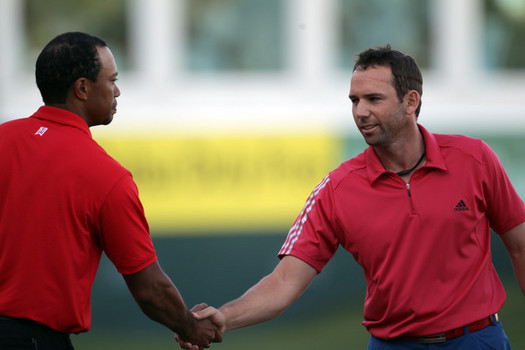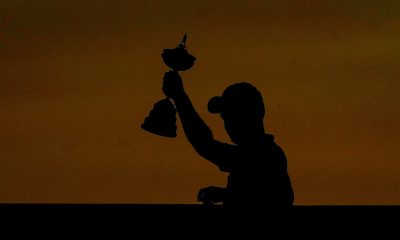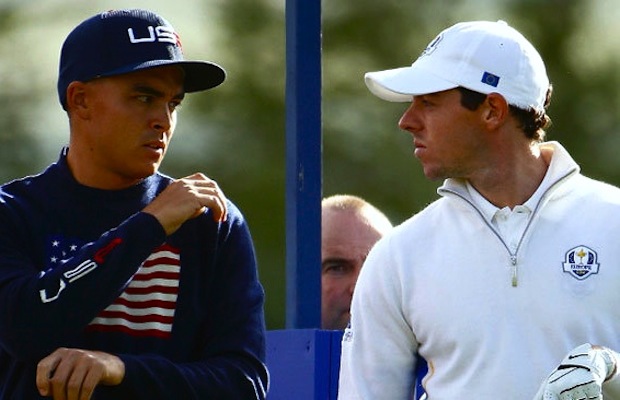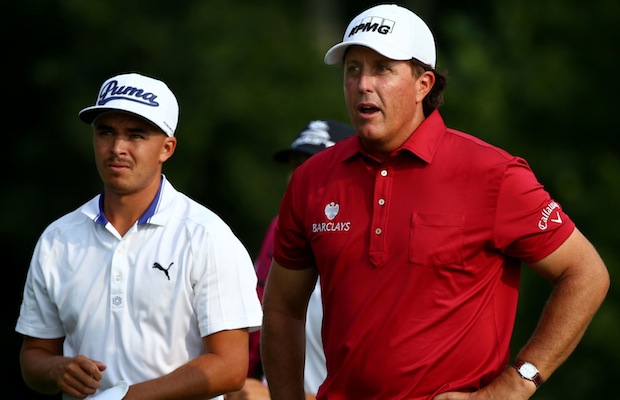Opinion & Analysis
Tiger shouldn’t play Rory in Ryder Cup Singles Matches

By John Wunder
GolfWRX Contributor
On Aug. 15, 1999 the world was witness to what potentially could have been one of the most exciting rivalries in golf history. It had all the makings of Nicklaus vs. Palmer or Hogan vs Snead. As a fan I feel somewhat cheated that it has yet to come to fruition but with clever pairings and a touch of luck we will have our chance to rekindle this soap opera.
Down the stretch at the PGA in 1999 held at Medinah. Tiger Woods battled Sergio Garcia shot for shot, it was an epic afternoon and as we all watched with bated breath Tiger finished just a nose ahead. I still remember his expression after he holed the final putt, it was one of the only times I can remember that I’ve seen Tiger truly relieved… and exhausted. The wide-eyed Garcia had pushed him to the brink.
Sergio, although playing in the group ahead that Sunday, managed to isolate himself and Tiger from the rest of the field and they both provided blow after blow including a shot from the trunk of a tree (which has since been cut down) that will go down as one of the greats.
So much has been made of Sergio’s heroics from the root of that tree, but that wasn’t the shot that lit the fire. It was the exchange at Nos. 12 and 13 that got it going. After Tiger had bogeyed No. 12 and walked on to the 13th tee he became audience to Garcia holing his 15 footer for birdie and than on cue pointing back up at the tee to where Tiger was standing. It was a challenge. That moment represented exactly what I believe Sergio envisioned for the rest of his career. He was going to be the one that challenged Tiger in the Majors — it was just going to be the two of them like Rocky and Apollo until one of them decided to stop.
As exciting as that would have been, we all know how the rest of the story plays out. Tiger went on to… well, he was Tiger Woods (enough said). And Sergio gave us flashes of brilliance, immaturity, heartbreak, confusion and even a little anger. Besides the random skins game or battle at Big Horn we never got a full taste of what could have been between these two.
I don’t think Sergio ever allowed himself to regulate his emotions. He, like his mentor Seve Ballesteros, plays with his heart on his sleeve. As time went on and Tiger continued to win, we saw Sergio’s fire dwindle. In his early 20s immaturity cost him a lot of big tournaments and in the 2002 U.S. Open his resentment for Tiger went on full display. He verbally expressed his opinion of favorable tee times to Tiger as an injustice by the USGA and favoritism. That’s when the true separation of these two players really occurred. Sergio wasn’t the wiry kid having fun anymore. He was just another player trying to figure out how to keep up with the juggernaut Woods.
Fast forward to this week at the Ryder Cup and the scene of their first face-off. Both men having been humbled by life and the game but who still have that chip on their shoulders that all the great ones have.
As a golf fan I feel if these two were to square off on Sunday for the Ryder Cup it would provide us with probably the most electrifying golf the sport has ever seen. Although their bodies of work aren’t exactly apples to apples, there is still unfinished business, especially for Garcia. I realize he won the Wyndham Championship this year, but I don’t think we have seen him in full flight. The grand performance is what drives him. The roar of the crowd or the act of silencing them. He hasn’t had his Madison Square Garden moment yet.
If the golf gods allow, Sunday will be the day. I know deep down that this matchup would fuel Tiger as well. These two had a relationship much like Rory and Tiger do now, but that changed. Success or lack there of will do that to a relationship.
Woods seems to harbor feelings for any naysayers he has ever had. Ask Stephen Ames or Rory Sabbatini, it hasn’t ended so well. There is something different about his relationship with Sergio, an unspoken flame that burns. Almost like Manny Pacquio and Floyd Mayweather, these two have more or less tip toed around each other for a decade. Now that life has balanced them both out and they seem to be standing flat footed on the planet, the golf can do all the talking. No resumes, no money, no FedExCup points. Just a Tiger and a Bull locked in a ring going at each other with everything they have. One player wanting to prove that he’s back and the other to prove that his best is still yet to come.
I understand that to a great majority a Tiger v. Rory match would be the one to hope for, but I disagree. It’s too early in McIlroy’s career for that. It’s too clean. That battle we can save for Augusta. Since it’s the Ryder Cup, there is a blood, sweat and tears aspect to this thing. Rory hasn’t had enough dirt kicked in his face, nor enough disappointment. He will get his chance soon enough.
The game needs this match as a reminder of just how beautifully volatile this relationship is. How many Ryder Cups have gone by with us just missing a true Tiger moment. His play in the Cup has been by his standards lack luster. I can’t recall a moment where the crowd erupted after a long putt and we got a glimpse of a Tiger fist pump. That can all change this week. It’s his turf he’s defending — he’s 2-0 at Medinah.
On the flip side, Sergio has represented his true form at the Ryder Cup. Watch past highlights of him as a player or as an assistant. It’s pure love of country and competition. It has not only been his greatest stage but the one thing that he can hang over Tiger’s head. Sergio has the ability to push Tiger on the course, physically and emotionally. It’s what he was born to do, that’s the essence of his game. He had a great teacher in Ballesteros.
Woods and Garcia are well aware of the magnitude of this potential face-off. Jose Marie Olazabel knows it and Captain Love is well aware I’m sure. The tension would be palpable.
Its time for Tiger vs. Sergio II. The rematch. It’s the perfect location, the perfect moment.
Trust me… this one you will never forget. It’s personal.
Opinion & Analysis
The 2 primary challenges golf equipment companies face

As the editor-in-chief of this website and an observer of the GolfWRX forums and other online golf equipment discourse for over a decade, I’m pretty well attuned to the grunts and grumbles of a significant portion of the golf equipment purchasing spectrum. And before you accuse me of lording above all in some digital ivory tower, I’d like to offer that I worked at golf courses (public and private) for years prior to picking up my pen, so I’m well-versed in the non-degenerate golf equipment consumers out there. I touched (green)grass (retail)!
Complaints about the ills of and related to the OEMs usually follow some version of: Product cycles are too short for real innovation, tour equipment isn’t the same as retail (which is largely not true, by the way), too much is invested in marketing and not enough in R&D, top staffer X hasn’t even put the new driver in play, so it’s obviously not superior to the previous generation, prices are too high, and on and on.
Without digging into the merits of any of these claims, which I believe are mostly red herrings, I’d like to bring into view of our rangefinder what I believe to be the two primary difficulties golf equipment companies face.
One: As Terry Koehler, back when he was the CEO of Ben Hogan, told me at the time of the Ft Worth irons launch, if you can’t regularly hit the golf ball in a coin-sized area in the middle of the face, there’s not a ton that iron technology can do for you. Now, this is less true now with respect to irons than when he said it, and is less and less true by degrees as the clubs get larger (utilities, fairways, hybrids, drivers), but there remains a great deal of golf equipment truth in that statement. Think about it — which is to say, in TL;DR fashion, get lessons from a qualified instructor who will teach you about the fundamentals of repeatable impact and how the golf swing works, not just offer band-aid fixes. If you can’t repeatably deliver the golf club to the golf ball in something resembling the manner it was designed for, how can you expect to be getting the most out of the club — put another way, the maximum value from your investment?
Similarly, game improvement equipment can only improve your game if you game it. In other words, get fit for the clubs you ought to be playing rather than filling the bag with the ones you wish you could hit or used to be able to hit. Of course, don’t do this if you don’t care about performance and just want to hit a forged blade while playing off an 18 handicap. That’s absolutely fine. There were plenty of members in clubs back in the day playing Hogan Apex or Mizuno MP-32 irons who had no business doing so from a ballstriking standpoint, but they enjoyed their look, feel, and complementary qualities to their Gatsby hats and cashmere sweaters. Do what brings you a measure of joy in this maddening game.
Now, the second issue. This is not a plea for non-conforming equipment; rather, it is a statement of fact. USGA/R&A limits on every facet of golf equipment are detrimental to golf equipment manufacturers. Sure, you know this, but do you think about it as it applies to almost every element of equipment? A 500cc driver would be inherently more forgiving than a 460cc, as one with a COR measurement in excess of 0.83. 50-inch shafts. Box grooves. And on and on.
Would fewer regulations be objectively bad for the game? Would this erode its soul? Fortunately, that’s beside the point of this exercise, which is merely to point out the facts. The fact, in this case, is that equipment restrictions and regulations are the slaughterbench of an abundance of innovation in the golf equipment space. Is this for the best? Well, now I’ve asked the question twice and might as well give a partial response, I guess my answer to that would be, “It depends on what type of golf you’re playing and who you’re playing it with.”
For my part, I don’t mind embarrassing myself with vintage blades and persimmons chasing after the quasi-spiritual elevation of a well-struck shot, but that’s just me. Plenty of folks don’t give a damn if their grooves are conforming. Plenty of folks think the folks in Liberty Corner ought to add a prison to the museum for such offences. And those are just a few of the considerations for the amateur game — which doesn’t get inside the gallery ropes of the pro game…
Different strokes in the game of golf, in my humble opinion.
Anyway, I believe equipment company engineers are genuinely trying to build better equipment year over year. The marketing departments are trying to find ways to make this equipment appeal to the broadest segment of the golf market possible. All of this against (1) the backdrop of — at least for now — firm product cycles. And golfers who, with their ~15 average handicap (men), for the most part, are not striping the golf ball like Tiger in his prime and seem to have less and less time year over year to practice and improve. (2) Regulations that massively restrict what they’re able to do…
That’s the landscape as I see it and the real headwinds for golf equipment companies. No doubt, there’s more I haven’t considered, but I think the previous is a better — and better faith — point of departure when formulating any serious commentary on the golf equipment world than some of the more cynical and conspiratorial takes I hear.
Agree? Disagree? Think I’m worthy of an Adam Hadwin-esque security guard tackle? Let me know in the comments.
@golfoncbs The infamous Adam Hadwin tackle ? #golf #fyp #canada #pgatour #adamhadwin ? Ghibli-style nostalgic waltz – MaSssuguMusic
Podcasts
Fore Love of Golf: Introducing a new club concept

Episode #16 brings us Cliff McKinney. Cliff is the founder of Old Charlie Golf Club, a new club, and concept, to be built in the Florida panhandle. The model is quite interesting and aims to make great, private golf more affordable. We hope you enjoy the show!
Opinion & Analysis
On Scottie Scheffler wondering ‘What’s the point of winning?’

Last week, I came across a reel from BBC Sport on Instagram featuring Scottie Scheffler speaking to the media ahead of The Open at Royal Portrush. In it, he shared that he often wonders what the point is of wanting to win tournaments so badly — especially when he knows, deep down, that it doesn’t lead to a truly fulfilling life.
View this post on Instagram
“Is it great to be able to win tournaments and to accomplish the things I have in the game of golf? Yeah, it brings tears to my eyes just to think about it because I’ve literally worked my entire life to be good at this sport,” Scheffler said. “To have that kind of sense of accomplishment, I think, is a pretty cool feeling. To get to live out your dreams is very special, but at the end of the day, I’m not out here to inspire the next generation of golfers. I’m not out here to inspire someone to be the best player in the world, because what’s the point?”
Ironically — or perhaps perfectly — he went on to win the claret jug.
That question — what’s the point of winning? — cuts straight to the heart of the human journey.
As someone who’s spent over two decades in the trenches of professional golf, and in deep study of the mental, emotional, and spiritual dimensions of the game, I see Scottie’s inner conflict as a sign of soul evolution in motion.
I came to golf late. I wasn’t a junior standout or college All-American. At 27, I left a steady corporate job to see if I could be on the PGA Tour starting as a 14-handicap, average-length hitter. Over the years, my journey has been defined less by trophies and more by the relentless effort to navigate the deeply inequitable and gated system of professional golf — an effort that ultimately turned inward and helped me evolve as both a golfer and a person.
One perspective that helped me make sense of this inner dissonance around competition and our culture’s tendency to overvalue winning is the idea of soul evolution.
The University of Virginia’s Division of Perceptual Studies has done extensive research on reincarnation, and Netflix’s Surviving Death (Episode 6) explores the topic, too. Whether you take it literally or metaphorically, the idea that we’re on a long arc of growth — from beginner to sage elder — offers a profound perspective.
If you accept the premise literally, then terms like “young soul” and “old soul” start to hold meaning. However, even if we set the word “soul” aside, it’s easy to see that different levels of life experience produce different worldviews.
Newer souls — or people in earlier stages of their development — may be curious and kind but still lack discernment or depth. There is a naivety, and they don’t yet question as deeply, tending to see things in black and white, partly because certainty feels safer than confronting the unknown.
As we gain more experience, we begin to experiment. We test limits. We chase extreme external goals — sometimes at the expense of health, relationships, or inner peace — still operating from hunger, ambition, and the fragility of the ego.
It’s a necessary stage, but often a turbulent and unfulfilling one.
David Duval fell off the map after reaching World No. 1. Bubba Watson had his own “Is this it?” moment with his caddie, Ted Scott, after winning the Masters.
In Aaron Rodgers: Enigma, reflecting on his 2011 Super Bowl win, Rodgers said:
“Now I’ve accomplished the only thing that I really, really wanted to do in my life. Now what? I was like, ‘Did I aim at the wrong thing? Did I spend too much time thinking about stuff that ultimately doesn’t give you true happiness?’”
Jim Carrey once said, “I think everybody should get rich and famous and do everything they ever dreamed of so they can see that it’s not the answer.”
Eventually, though, something shifts.
We begin to see in shades of gray. Winning, dominating, accumulating—these pursuits lose their shine. The rewards feel more fleeting. Living in a constant state of fight-or-flight makes us feel alive, yes, but not happy and joyful.
Compassion begins to replace ambition. Love, presence, and gratitude become more fulfilling than status, profits, or trophies. We crave balance over burnout. Collaboration over competition. Meaning over metrics.
Interestingly, if we zoom out, we can apply this same model to nations and cultures. Countries, like people, have a collective “soul stage” made up of the individuals within them.
Take the United States, for example. I’d place it as a mid-level soul: highly competitive and deeply driven, but still learning emotional maturity. Still uncomfortable with nuance. Still believing that more is always better. Despite its global wins, the U.S. currently ranks just 23rd in happiness (as of 2025). You might liken it to a gifted teenager—bold, eager, and ambitious, but angsty and still figuring out how to live well and in balance. As much as a parent wants to protect their child, sometimes the child has to make their own mistakes to truly grow.
So when Scottie Scheffler wonders what the point of winning is, I don’t see someone losing strength.
I see someone evolving.
He’s beginning to look beyond the leaderboard. Beyond metrics of success that carry a lower vibration. And yet, in a poetic twist, Scheffler did go on to win The Open. But that only reinforces the point: even at the pinnacle, the question remains. And if more of us in the golf and sports world — and in U.S. culture at large — started asking similar questions, we might discover that the more meaningful trophy isn’t about accumulating or beating others at all costs.
It’s about awakening and evolving to something more than winning could ever promise.





















obmoc67
Sep 28, 2012 at 9:57 pm
great article, never thought about it.